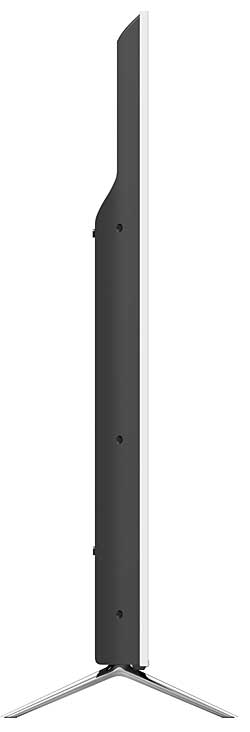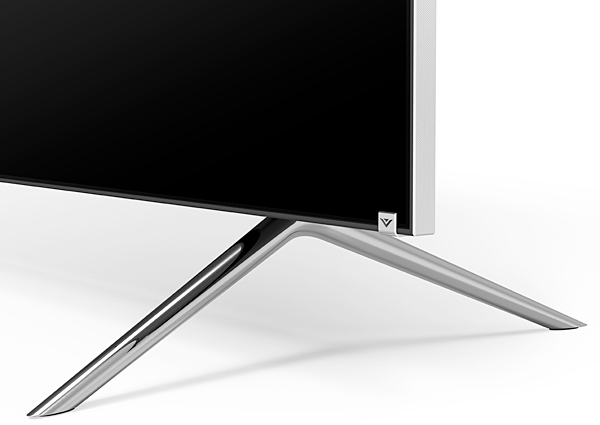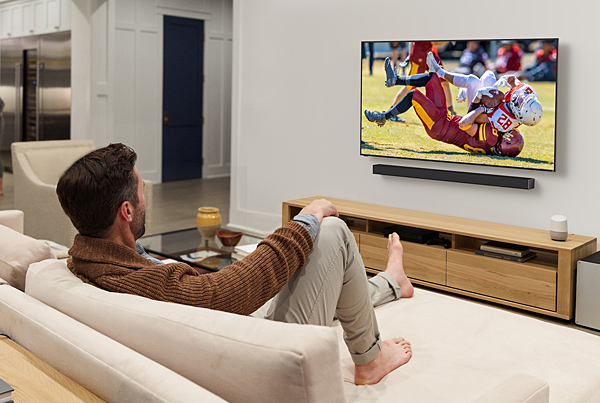Vizio PX75-G1 P-Series Quantum X LCD Ultra HDTV Review Page 2
Even after a full calibration I found that the PX75-G1's colors often looked a bit overcooked, particularly skin tones. A small reduction in the Color control, usually around 47 give or take a step or two (the default is 50) for both SDR and HDR often was the only change needed. For SDR I sometimes also increased the Backlight from 20 to 25 for a little more pop and varied the Gamma control depending on the source from 2.2 to 2.4. For HDR I increased the Contrast from 50 to 53 depending on the source.
Hd/Standard Dynamic Range Performance
I used Blu-ray (HD and UHD) played on an Oppo UDP-203 Ultra HD Blu-ray player for all of my serious viewing, but also spent considerable time watching streamed video. Home Alone 2: Lost in New York is an underappreciated Christmas film that I pulled from the shelf just after the holidays. This is a beautiful transfer of a well-shot film, and its rich, brilliant colors were appropriate for the season. As Kevin navigates the city and outwits the sticky bandits bot in his uncle's house and in Central Park, I was impressed with the Vizio's color, detail, sharpness, and overall performance in bright and dark scenes.
 Oblivion is a disc I've referenced many times (including below in its HDR form) for good reason since it's a superb transfer. It looked good across the board on the Vizio, with solid color, faultless detail, and well-balanced contrast. Prometheus is also a superb disc, though a little trickier for displays to deal with due to its many dark cave scenes. The Vizio handled it reasonably well, though the dark scenes looked just a little grayer than they do on an OLED TV. The star fields early on in the film looked totally convincing, however. Typical of most LCD designs, the Vizio looks best when viewed head-on. Picture quality starts to deteriorate as you move off-center, the loss of contrast becoming obvious once you view from 20-25 degrees to one side.
Oblivion is a disc I've referenced many times (including below in its HDR form) for good reason since it's a superb transfer. It looked good across the board on the Vizio, with solid color, faultless detail, and well-balanced contrast. Prometheus is also a superb disc, though a little trickier for displays to deal with due to its many dark cave scenes. The Vizio handled it reasonably well, though the dark scenes looked just a little grayer than they do on an OLED TV. The star fields early on in the film looked totally convincing, however. Typical of most LCD designs, the Vizio looks best when viewed head-on. Picture quality starts to deteriorate as you move off-center, the loss of contrast becoming obvious once you view from 20-25 degrees to one side.
Ultra Hd/High Dynamic Range Performance
Revisiting Oblivion, but this time in HDR, I was blown away by how the Vizio handled the disc's bright HDR highlights. The lightning strikes in the first act looked frighteningly real, and a nighttime nuclear explosion seen from a distance revealed more detail than I've ever noticed in the dozens of times I've watched it before on other sets.
Other bright details throughout Oblivion, while not always as spectacular, were nonetheless jaw-dropping. As Jack is chained up and questioned by the "Scavs," he sits in the dark illuminated only by a bright spotlight. In most displays this appears either as a single light source or as multiple sources mushed together, but on the Vizio it was revealed as three closely spaced but clearly differentiated lights.
Such detail is made possible by the Vizio's high peak light output in HDR. When properly set up, it measured 2,000 nits on highlights—almost double what we've measured on other sets, and three times what you get with an OLED TV. OLEDs typically top out at about 700 nits, while a Samsung Q90 series LCD model we tested in the December/January 2020 issue (also on soundandvision.com) measured 1,300 nits—a previous high mark in our TV testing history. Although the human eye doesn't respond linearly to increasing light levels (if it did, we'd go blind walking outside on a sunny day!), the peak white available from the Vizio PX75-G1 makes resolution of such bright details possible. In more technical terms, this set delivers enough brightness that it doesn't need to employ tone mapping for most HDR sources.

There's more to HDR than just peak white output, of course. Though the Vizio's screen usually went completely black on fadeouts between scenes in SDR, it never did so in HDR, instead stopping at a very dark gray. But black bars on widescreen films were always inconspicuous with either SDR or HDR as long as relatively bright material was in the active picture area—with one exception. As with all local dimming LCD TVs I've reviewed, haloing appeared around bright objects, an effect that was most visible when they were set against a black background. This also applied to widescreen material when a bright object abutted the top or bottom letterbox bar. I never found this distracting when watching movies or TV, but your reaction may differ. (Haloing is typically more obvious in HDR than in SDR due to the former's extreme brightness on highlights.)
The PX75-G1 did occasionally show an HDR issue often seen on other TVs—a sometimes too-dark look on scenes with a middling average brightness level. Turning the Contrast up to 53-54 for HDR programs helped to overcome this, though it wasn't a total cure. In general, the Vizio's black levels with HDR were good, though a bit less inky than with SDR. On some programs I had to choose between the image being a bit too light or exhibiting slightly crushed blacks (for example, in the night forest scene in Guardians of the Galaxy Vol.2). But overall, HDR performance was the best I've yet seen, with consistently satisfying contrast, and colors that always looked rich.

Vizio's TV offered reasonably good screen uniformity with both HDR and SDR. If you look very closely at dark gray, full-field test patterns, you might see subtle vertical bands. But that's being incredibly picky, and I never saw any uniformity issues when watching movies or TV programs. Nor did I see white clipping or false contouring on any of the sources I watched. As noted earlier, starfields did look effective on the PX75-G1, though the starfield test on the Spears & Munsil UHD HDR Benchmark test disc didn't come close to what's possible with the same pattern viewed on an OLED TV. That's because starfields represent pinpoints of light, and even highly effective local dimming can't always reliably illuminate such tiny highlights.
Conclusion
Vizio may have made its mark as a value leader in TV, but its launch of a set priced at more than two grand doesn't mean the company is abandoning that stance. Look again at what you get here for $2,200: Smart TV features, a 75-inch screen with 480 local dimming zones, and high dynamic range performance that competes with the best. If you can find a better overall performer at this screen size for under $2,500, by all means go for it. If not, and I suspect you won't, the Vizio P-Series Quantum X might just be your next TV.



























































